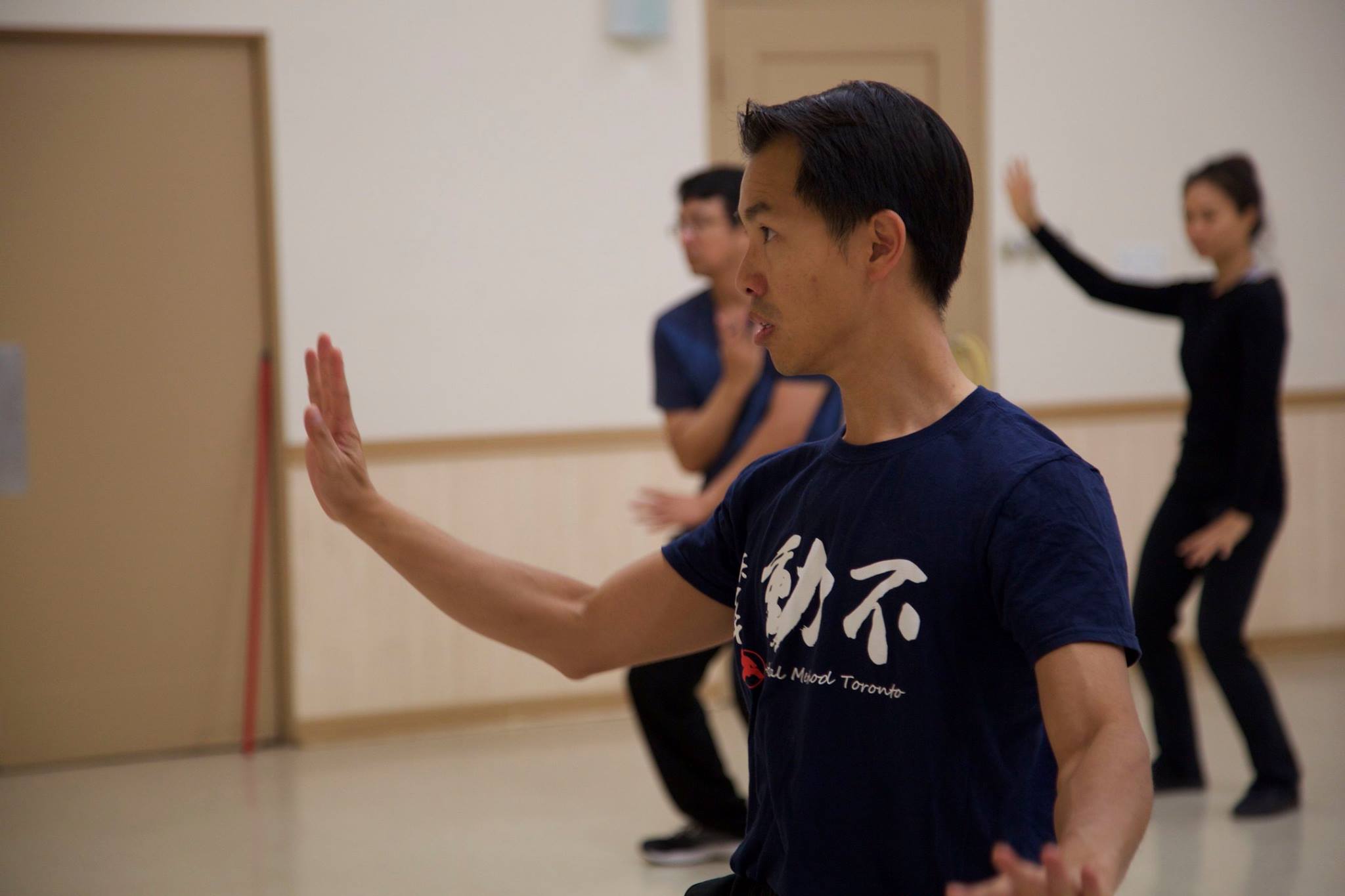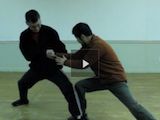
We had 19 people attending the Toronto workshop this time. 5 of them were first timers. We started off with Master Chen talking about the positive circle, and continuously focusing on its various aspects.
Here are my notes:
- Only move your foot forward towards the opponent, everything else does not go towards the opponent.
- Don’t do the action you want to do, do the opposite.
- Power comes from the back.
- Positive circle: only rotate the elbow, shoulder, kua, waist
- One of my students told me that Master Chen told him to be song/relax at the elbow, which was contrary to what I told him before. I asked him to go back to Master Chen to ask him to clarify since I wasn’t present in the original conversation. It turned out Master Chen was telling him not to tighten the muscle the way he did at the time. The student took as needing to being “song” using his prior non-Practical Method understanding of the word. The lesson to me was hat 1) we couldn’t use our previous understanding to learn new things, 2) there was no need to guess when we can ask directly.
- To get power, train power
- Exercise: To train power. Hold up right hand, move only the the fingers. Make sure the power does not get stuck on the right shoulder.
- Stick, rope and rock. Stick and Rope are the yin and yang. Stick is hard material of the body: bones. Rope is the soft material in the body: muscles, ligaments. Rock is the dot (not moving point). The Rope needs to wrap around the stick.
- Power is only created by differential of speed. That’s why tossing produces no power.
- Cover more space means more speed, e.g. hand-elbow differential (first and second count of positive circle)
- Catch the opponent on the top, move the bottom. Always finish the move I set out to do regardless of whether it will be successful or not.
- Once I catch the opponent, zoom into/focus the power/aim at one point on the opponent, e.g. press down on his front kua.
- Rotate waist/kua exercise: Elbow in, lock the elbow to the front kua, rotate the front kua. Look for the special spot where the elbow is tied to the kua. This is used to train kua power.
- Kua needs to be the leader in each move.
- Different stages of power: tearing, shearing, explosion, implosion.
- Ding zhu liang tou da zhong Jian 定住两头打中间。Fix the two ends, break/move/rotate the middle, e.g. the opponent is pushing my chest, I put my hand on his shoulder. My hand and his hand (the two ends) forms a line, put force in his elbow (middle) to break it.
- Anything that you are not used to, you will feel it to be bigger/more abnormal than usual.
- Zhuan Guan/转关/Turning over of the joint produces mysterious power. Master Chen may also say “to go over” or “to go to the other side” or “to go over the threshold”. We do need to create the threshold, and go over the threshold without moving the threshold (Yin/Yang separation).
- Outer space is anywhere above the ground. Project that dot into outer space, so that it is not rooted/supported by the ground.
- Carry out your agenda, don’t derail.
- When your movement is done right, it is very clear. Don’t drag other things into it.
- Place your power where it needs to be.
- Push Hands: Engage and lock the top, move the feet.
- I must finish the move otherwise the position I am in is dangerous for me. Similarly if someone comes in, I must act otherwise I am in a dangerous position.
- Lock the chest, in with elbow. Lock the back, out with hand.
- Find the dot behind to match the forward action. Exercise: Hit that dot on the back to the wall.
- Horizontal moves are supported by vertical support. Vertical moves are supported by horizontal support. Think of how a typical backyard wood fence is set up.
- To pull (in with elbow), lock on one dot, the feet come up to that dot to lock it.
- Taiji is a balancing act. Match the opponent 50/50 for a long time (learn to move the counter weight). Later, one can change the pivot position to create a long lever that can be used to overthrow the opponent.
- Earth is dantian. Earth nourishes things so they can grow. Once they leave the earth, the sun will cause them to die and go back to the earth.
- Five fixed points cause rotation.
- Intent is pure energy movement without displacement.
- Exercise: Find the opposite dot to the hand. Push the dot against the wall.
- Suck, stick swallow, spit
实用拳法:对吸,贴,吞,吐
混元:敷,盖,对吞
Once you suck, it sticks to the back, swallow down, and spit it out. - If someone pushes on my chest, I want to connect it to a dot on my back, and split that energy on the chest. The split is like creating a dish on the front while keeping the back straight.
- Everything has to go to a focal point.
- Stance: Put a bar beside the inner knee/calf. For any forward movement, the inner knee can’t press into the bar.
- Positive Circle: Not moving the shoulder. Front ribs pointing to the front, elbow move to the chest, front shoulder/kua line not moving. Hand out, shoulder not moving, shoulder/kua line not moving.
- Cable-like action: Point under bicep, pulled by point on the side ribs, then pulled by point under thigh.
- While checking my half horse stance, Master Chen said that my waist was too thin.
- Horse stance: it’s like there is a ball underneath. You can’t squeeze a horse while sitting on it, there is always a curve under you.
- Principles->Concepts->Actions: When in doubt, always go back to the principles.
- Elbow in exercise: To get rid of the shoulder during the pull, connect a dot at the back thigh with a point in the front upper arm.
- If I understand it, I can do it. If I can’t do it, I don’t really understand.
- Don’t lose track. Stay on it.
- Exercise: Let the opponent grab my forearm with both hands, push and stop in front of the grabbing point, switch to behind the grabbing point to pull (it’s a pull relative to the grabbing position).
- Exercise: In order to conquer the fear of falling, Master Chen asked us to get in against the opponent to the point that we fall by ourselves. He said you were already very close to the floor in that position, it shouldn’t really hurt. We also did one variation of it that we got in and switch to go to the other side.
Sandy Doeur’s Toronto Workshop notes can be found at:
http://practicalmethod.com/2015/10/toronto-october-2015-workshop-notes
Paddy Hanratty’s Toronto Workshop notes can be found at:
http://practicalmethod.com/2015/10/toronto-october-workshop-notes/



{ 3 comments… read them below or add one }
Thanks for sharing Kevin! Great notes, and good reminders!
Thanks kelvin, great notes.
Thanks Kelvin…really a big help.